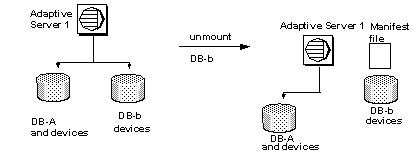
![]() unmount allows you to identify more
than one database for a move operation. However, if a device is
used for more than one database, then all of the databases must
be moved in one operation. You specify the set of databases being
transported. The devices used by these databases cannot be shared
with any extraneous database besides the ones specified in the command.
unmount allows you to identify more
than one database for a move operation. However, if a device is
used for more than one database, then all of the databases must
be moved in one operation. You specify the set of databases being
transported. The devices used by these databases cannot be shared
with any extraneous database besides the ones specified in the command.
When you unmount a database, you remove the database and its devices from an Adaptive Server. The unmount command shuts down the database. All tasks using the database are terminated. The database and its pages are not altered and remain on the operating system devices.
The unmount command limits the number of databases that can be moved in a single command to eight.
The unmount command:
Shuts down the database,
Drops the database from the Adaptive Server,
Deactivates and drops devices,
Uses the manifest_ file extension to create the manifest file.
Once the unmount command completes, you can disconnect and move the devices at the source Adaptive Server if necessary.
unmount database <dbname list> to <manifest_file> [with {override, [waitfor=<delay time]} ]
For example:
1> unmount database pubs2 to "/work2/Devices/Mpubs2_file" 2> go
If you now try to use the pubs2 database, you see this error:
Attempt to locate entry in sysdatabases for database 'pubs2' by name failed - no entry found under that name. Make sure that name is entered properly.
![]() When the referencing database is dropped by the unmount command
with an override, you cannot drop the referential constraints (dependencies)
or table.
When the referencing database is dropped by the unmount command
with an override, you cannot drop the referential constraints (dependencies)
or table.